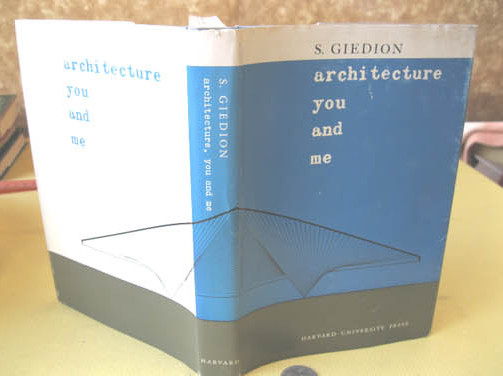Siegfried Giedion: Architecture, You and Me: The Diary of a Development (1956/1958)
Filed under book | Tags: · architecture, art, city, history of architecture, painting, sculpture, urbanism

Collection of essays from 1937-1956 by an influential Prague-born and Switzerland-based historian and critic of architecture.
First published in German as vol. 18 of the Deutsche Enzyklopaedie under the title Architektur und Gemeinschaft by Rowohlt, Hamburg, 1956
Translated by Jaqueline Tyrwhitt
Publisher Harvard University Press, Cambridge, MA, 1958
221 pages
Review: Harold Ehrensperger (The Saturday Review).
Comment (0)Sibyl Moholy-Nagy: Moholy-Nagy – Experiment in Totality (1950–)
Filed under book | Tags: · architecture, art, art history, bauhaus, biography, constructivism, graphic design, history of architecture, painting, typography

“This biography of the Constructivist leader László Moholy-Nagy illustrates his struggle for a total approach to seeing-teaching-creating. Written by Sibyl Moholy-Nagy, László’s second wife and lifetime collaborator, she witnessed many of the defining moments of the Bauhaus movement and its migration to the United States and its continuation as the Chicago New Bauhaus and Institute of Design. An excellent first-person account.”
With an Introduction by Walter Gropius
Publisher Harper & Brothers, New York, 1950
262 pages
Second edition
Publisher MIT Press, 1969
xviii+259 pages
PDF (1950)
Internet Archive (1950, multiple formats)
PDF (2nd ed., 1969, added on 2020-1-3)
Le Corbusier: Towards a New Architecture (1923–)
Filed under book | Tags: · architecture, city, history of architecture, urbanism

“For the Swiss-born architect and city planner Le Corbusier, architecture constituted a noble art, an exalted calling in which the architect combined plastic invention, intellectual speculation, and higher mathematics to go beyond mere utilitarian needs, beyond ‘style,’ to achieve a pure creation of the spirit which established ’emotional relationships by mean of raw materials.’
The first major exposition of his ideas appeared in Vers une Architecture (1923), a compilation of articles originally written by Le Corbusier for his own avant-garde magazine L’Esprit Nouveau. The present volume is an unabridged English translation of the 13th French edition of that historic manifesto, in which Le Corbusier expounded his technical and aesthetic theories, views on industry, economics, relation of form to function, the “mass production spirit,” and much else. A principal prophet of the “modern” movement in architecture, and a new-legendary figure at the “International School,” he designed some of the twentieth century’s most memorable buildings: Chapel at Ronchamp; Swiss dormitory at the Cite Universitaire, Paris; Unite d’Habitation, Marseilles; and many more.
Le Corbusier brought great passion and intelligence to these essays, which present his ideas in a concise, pithy style, studded with epigrammatic, often provocative, observations: ‘American engineers overwhelm with their calculations our expiring architecture.’ ‘Architecture is stifled by custom. It is the only profession in which progress is not considered necessary.’ ‘…a cathedral is not very beautiful…’ and ‘Rome is the damnation of the half-educated. To send architectural students to Rome is to cripple them for life.’
Profusely illustrated with over 200 line drawings and photographs of his own works and other structures he considered important, Towards a New Architecture is indispensable reading for architects, city planners, and cultural historians – but will intrigue anyone fascinated by the wide-ranging ideas, unvarnished opinions and innovative theories of one of this century’s master builders.” (from the back cover)
Note: This translation of the book has also been a source of controversy with regard to its change of style and very specific alterations to the text. The alterations have generated criticism and required correction, even as some of them began to define architectural language. A new translation was released in 2007 that is meant to be truer to Le Corbusier’s intention. (from Wikipedia)
Originally published in French under the title Vers une architecture, Paris, 1923.
This edition, first published in 1986, is an unabridged and unaltered republication of the work originally published by John Rodker, London, in 1931, as translated from the thirteenth French edition and given an English introduction by Frederick Etchells
Publisher Dover Publications, New York
ISBN 0486250237, 9780486250236
320 pages
PDF (no OCR)
Comment (0)
